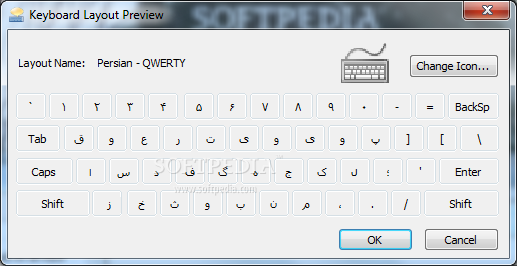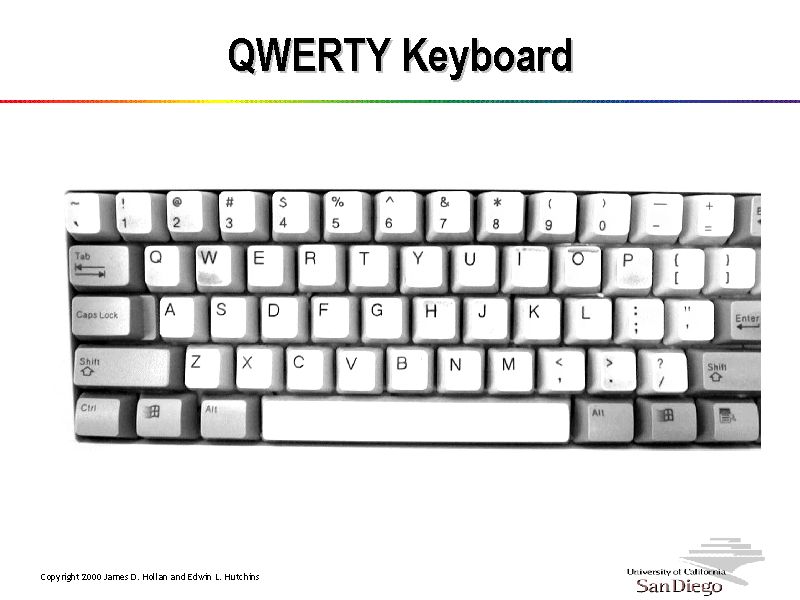

The QWERTY layout depicted in Sholes's 1878 patent includes a few differences from the modern layout, most notably in the absence of the numerals 0 and 1, with each of the remaining numerals shifted one position to the left of their modern counterparts. Latham Sholes's 1878 QWERTY keyboard layout Differences from modern layout Substituting characters File:QWERTY 1878.png Some keyboards, such as the Kinesis, retain the QWERTY layout but arrange the keys in vertical columns, to reduce unnecessary lateral finger motion. Much less commented-on than the order of the keys is that the keys are not on a grid, but rather that each column slants diagonally this is because of the mechanical linkages – each key being attached to a lever, and hence the offset prevents the levers from running into each other – and has been retained in most electronic keyboards. 2 of 1878, the first typewriter to include both upper and lower case letters, via a shift key. The QWERTY layout became popular with the success of the Remington No. Vestiges of the original alphabetical layout remained in the " home row" sequence DFGHJKL. Their adjustments included placing the "R" key in the place previously allotted to the period key (this has been claimed to be done with the purpose of enabling salesmen to impress customers by pecking out the brand name "TYPE WRITER" from one keyboard row but this claim is unsubstantiated ). The keyboard ultimately presented to Remington was arranged as follows: Template:QuotationĪfter it purchased the device, Remington made several adjustments which created a keyboard with what is essentially the modern QWERTY layout. Remington and Sons, and within a few months the keyboard layout was finalized by Remington's mechanics.

In 1873 Sholes's backer, James Densmore, succeeded in selling manufacturing rights for the Sholes & Glidden Type-Writer to E. In April 1870 he arrived at a four-row, upper case keyboard approaching the modern QWERTY standard, moving six vowels, A, E, I, O, U, and Y, to the upper row as follows: Template:Quotation

In November 1868 he changed the arrangement of the latter half of the alphabet, O to Z, right-to-left. His study of letter-pair frequency by educator Amos Densmore, brother of the financial backer James Densmore, is believed to have influenced the arrangement of letters, but called in question. Sholes struggled for the next five years to perfect his invention, making many trial-and-error rearrangements of the original machine's alphabetical key arrangement. The solution was to place commonly used letter-pairs (like "th" or "st") so that their typebars were not neighboring, avoiding jams.Ī popular myth is that QWERTY was designed to "slow down" typists though this is incorrect – it was designed to prevent jams while typing at speed, allowing typists to type faster. Consequently, jams were especially serious, because the typist could only discover the mishap by raising the carriage to inspect what he had typed. Secondly, its printing point was located beneath the paper carriage, invisible to the operator, a so-called "up-stroke" design. His "Type Writer" had two features which made jams a serious issue.įirstly, characters were mounted on metal arms or typebars, which would clash and jam if neighboring arms were depressed at the same time or in rapid succession. The first model constructed by Sholes used a piano-like keyboard with two rows of characters arranged alphabetically as follows: Template:Quotation Soule he built an early writing machine for which a patent application was filed in October 1867. With the assistance of his friends Carlos Glidden and Samuel W. This layout was devised and created in the early 1870s by Christopher Latham Sholes, a newspaper editor and printer who lived in Milwaukee. Main article: Sholes and Glidden typewriter Keys are arranged on diagonal columns, to give space for the levers. History and purposes File:Continental Standard typewriter keyboard - key detail.jpg 5 Diacritical marks and international variants.


 0 kommentar(er)
0 kommentar(er)
